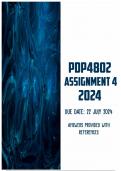, PLEASE USE THIS DOCUMENT AS A GUIDE TO ANSWER YOUR ASSIGNMENT
Please note that the author of this document will not responsibility for any plagiarizing you
commit.
The case of Katlego
You, as a member of the school-based support team (SBST), peruse a class teacher’s observation notes
on a learner. The learner, Katlego, has to repeat Grade 1. He is an only child and both his parents are
successful professionals. When Katlego’s teacher raised concerns about his lack of progress, his
parents appointed an au pair to assist with his care and homework. However, the teacher is still
concerned and discusses her observations with you.
She wrote the following:
He is well groomed.
His drawings are exceptional.
Sudden disturbed muscular control or awkwardness or clumsiness and a lack of co- ordination,
which do not correlate with his usual actions. He stumbles or bumps into things or drops them.
He sometimes inexplicably feels strange in an environment which should be familiar to him; for
example, he cannot open a door which he is usually able to open (he turns the handle the wrong
way).
Associated movements e.g. if he is busy drawing, his tongue makes strange accompanying
movements as well. Or if one hand is moving, the other hand also makes the same movements.
Achievements fluctuate – especially an inconsistent memory. What he knows one day, he forgets
the next and the day after he suddenly remembers again.
Signs of confusion without any reasonable cause. He suddenly appears disorientated; it looks as if
the familiar environment of the class is strange to him
Sometimes he stops writing. After a while, when he continues, his handwriting is very untidy.
He often does not finish assignments.
He daydreams and fails to concentrate.
He is a loner and often fights with other children.
Sometimes simply “difficult” behaviour.
He cannot read sight words and still sounds the words.
Question 1
1. Taking the case of Katlego as described above into account, hypothesise (speculate or
brainstorm) about possible risk factors (as briefly discussed in 3.2, LU 3) that may cause or
contribute to Katlego’s lack of progress and challenging behaviour in Grade 1. Structure your
answer as follows for each of at least four (4) hypotheses:
State the hypothesis.
Provide the reason(s) for your argumentation.
Suggest a possible way forward.
Indicate whether you accept or reject the hypothesis.




